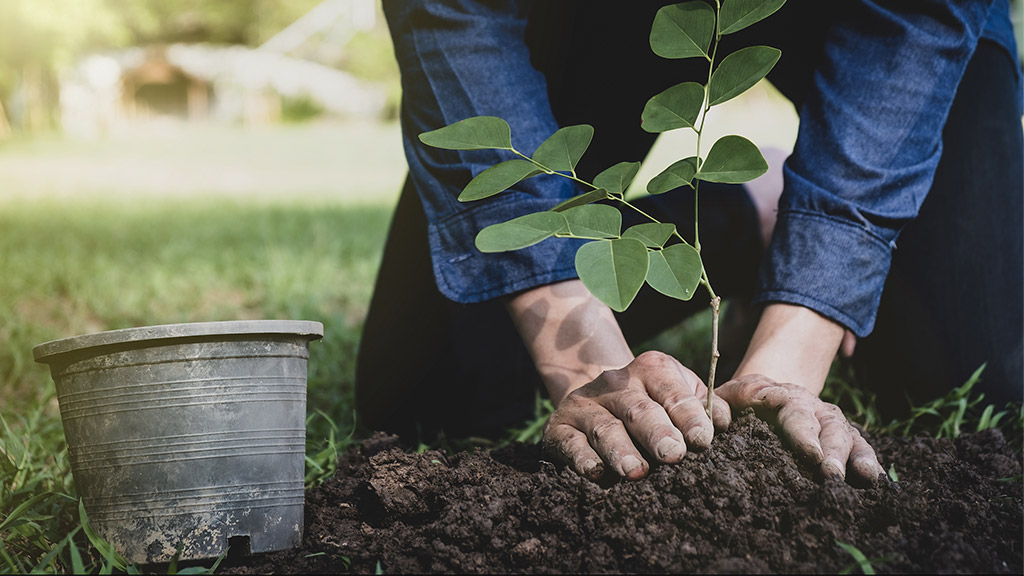AnonymousThe best time to plant a tree is twenty years ago. The second-best time is now.
In reality, the best time to plant a tree in Aotearoa is autumn. But like the saying above, we could argue that the second-best time is now — meaning, if you plant it and look after it, it should grow well.
Another saying, common in the landscape industry, is “It’s better to dig a five-dollar hole for a fifty-cent plant than to dig a fifty-cent hole for a five-dollar plant.” Preparation is the key to success when it comes to planting trees.
The text included in this section is provided by Germinate Aotearoa and is kindly reproduced with their permission.
Tree planting notes
The guide is specific to planting large trees but can be used for shrubs or smaller trees too. In these cases, the diameter of the hole can be twice the diameter of the root ball.
The guide is specific to planting trees supplied in planter bags (PBs), pots, or balled and burlapped (where the plant roots are in dirt and the root ball is wrapped in fabric). If planting bare-rooted trees, refer to step 7.
The step-by-step guide to planting trees
Step 1: Assemble your tools and materials
Gather the following tools and materials:
Tools
- Post rammer, or sledgehammer and stake protector*
- Scissors
- Secateurs (may be required for removing snapped branches)
- Spade
- Staple gun or staple
- Tarpaulin
- Watering can, or hose
- Wheelbarrow.
* A stake protector is a block of wood that can be placed on top of the stake to stop the stake from splitting when hammered in. It has a few smaller pieces of timber screwed into it to keep it on top of the stake as you hammer it in. See step 7 for instructions on how to make your own.
Materials
- Compost – 1x 20l bag
- Soft tree tying cord – 2m approx.
- Mulch – 1x 20l bag of organic bark chip mulch
- Organic seaweed liquid fertiliser, such as Seasol or Tui organic seaweed tonic
- Stakes – 2x 50x50mm pointed 1.5m
- Staples to fit the staple gun
- Tree.
Step 2: Prepare the tree for planting
- Fill a watering can with water and dilute the liquid fertiliser in accordance with the instructions on the packaging. Or attach the hose-on adapter bottle to your hose, as per the instructions.
- Water the tree thoroughly in its bag, ball, or pot, with the diluted liquid fertiliser solution until the root ball is soaked.
- Remove any nursery stakes by cutting the plastic ties and pulling the stake up and out of the root ball.
Step 3: Prepare the hole
- Identify the planting location according to the planting plan.
- Place the tarpaulin next to the working area.
- Dig a circular hole that is three times the diameter of the root ball.
- If planting in a garden bed, scrape back any compost or mulch before digging.
- If planting in lawn, refer to the instructions in step 7.
- Dig the hole deeper and stockpile the topsoil on the tarpaulin.
- If the soil changes colour significantly this means you are now digging a different soil horizon.
- Periodically check the depth of the hole and compare this to the height of the root ball. The depth of the hole needs to be the same as the height of the root ball.
- When the hole is complete, score the edges by slicing them with the spade. This will make it easier for the roots to penetrate the surrounding soil in the future.
- If the hole is especially dry, lightly water the bottom of the hole with the diluted liquid fertiliser solution. If water pools in the hole, give it time to drain out before moving to Step 4.
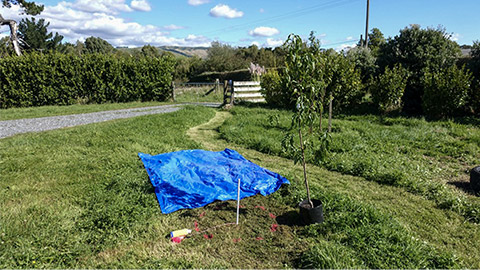

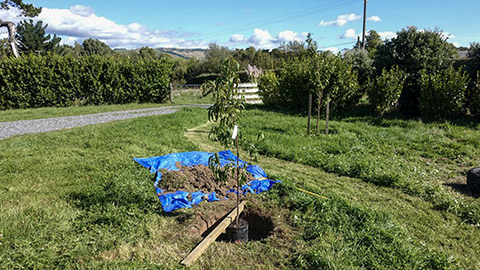
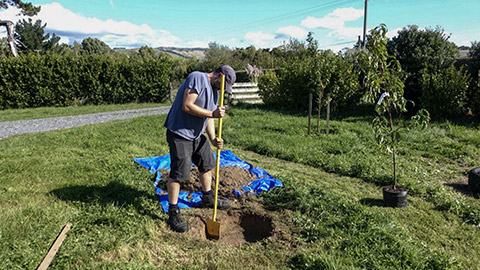
Step 4: Plant the tree
- Cut the bag that holds the tree on opposite sides but leave the bag in place.
- If the tree is in a large pot, remove it from the pot by tipping the pot upside down — taking care not to damage the trunk or branches — tapping the pot hard and pulling it off. You might need an assistant to help with this.
- If the tree is in burlap, untie the burlap and fold it down.
- If roots are visible at the edges of the root ball and these wrap around it tightly, gently tease them out with your fingers to free them up.
- Place the tree in the hole by, either:
- lifting it by the bag and then when it’s in the hole, sliding the bag out from under it, or
- placing one hand on the trunk at the top of the root ball and one under the root ball and lifting it into the hole.
- Rotate the tree so the best side is facing “forward.”
- If the tree has been grafted, position it so that when the wind blows from the strongest wind direction, it pushes the graft union closed.
- Ensure the root ball is level, and most importantly, the trunk points directly up.
- If staking is needed (see note below), hammer two stakes into the hole on opposite sides of the root ball, but not into the root ball.
- Put one stake on the windward side of the tree, and the other on the leeward side.
- Ensure they remain vertical as you hammer them in.
- Hammer each stake until 1/3 of the stake is in the ground and ⅔ remains above the surrounding ground level. For a 1.8m stake, 1.2m should be above ground, and for a 1.5m stake 1.0m should be left above ground).
- Fill in the hole, placing the subsoil in first.
- Do not add any additives, such as compost or mulch to the bottom or side of the hole. These are to be added to the top, to mimic nature’s processes (leaf litter breakdown).
- Press the soil down as you go to remove any air pockets that may form. You don’t need to press too hard, just enough to make it feel firm.
- Fill in with the remaining topsoil and firm it down as you go.
- If planting into a garden bed, ensure the finished surface is level with the surrounding group.
- If planting into a lawn, refer to step 7a.
- Spread 30-50mm of compost on top of the soil.
- Top with bark mulch 50-100mm deep.
- Pull the compost and mulch back from the trunk about 20mm. This will help prevent the mulch from burning the trunk as it decomposes.
- Water the tree again with the liquid fertiliser solution.
- Remove all debris to leave the site tidy.
Note: Staking is only needed when:
- trees are supplied ‘bare rooted’ (no soil around the roots) – refer to additional instructions in Section 7, or
- trees are large specimens, over 1.5m tall, or
- the site is particularly exposed to strong winds.
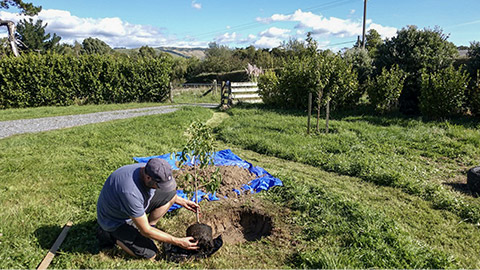
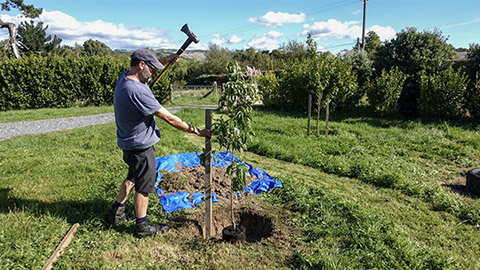
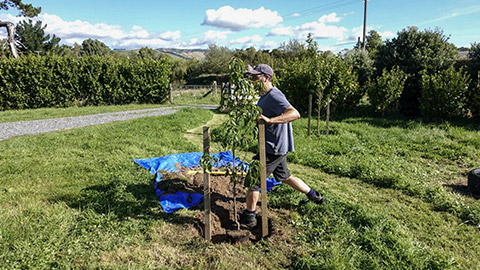
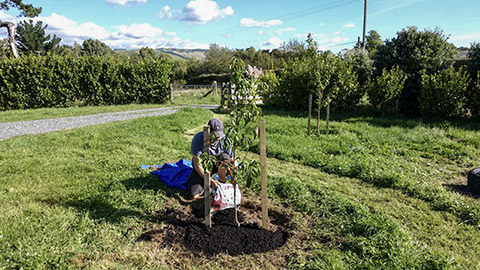
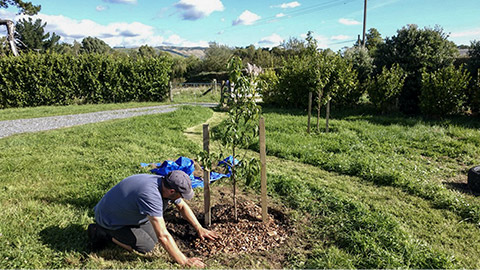
Step 5: Tie the tree
If you are staking the tree, do the following, if not, go to step 6.
- Cut a length of soft tree tying cord long enough to create a figure of eight between one stake and the tree.
- Staple one end to the side of the stake using 2-3 staples about ⅔ of the way up the stake (700-800mm approx.). If branches prevent you from tying at this height, move down so you’re under them.
- Pass the cord around the tree in a figure of eight and then back to the other side of the stake.
- Ensure the cord is firm but not tight. Staple it 2-3 times.
- Cut off any excess cord.
- Repeat the process for the second stake, 100-200mm lower than the first.
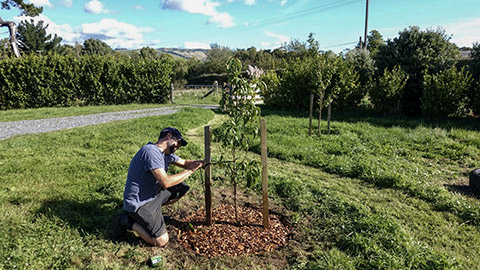
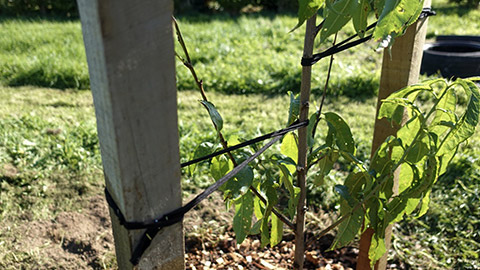
Step 6: Care for the tree during the establishment
- Deep water the tree once a week during summer if no significant rain has fallen that week. Run a hose at low flow (5-10 litres per min) and leave it on the root ball for 5 minutes.
- Remove weeds as they appear.
- Leave the stakes in place until the tree’s roots are established. This should only take one growing season (12 months) so set a reminder on your phone or add a note to your calendar to remove the stakes in one year.
- Early each spring, apply a layer of compost and bark mulch, the same thickness as the first year. This will help keep your tree growing strong.
Step 7: Other situations
Making a stake protector
If you’re hammering your stakes with a sledgehammer, your stakes may split. It is recommended that you place a block of wood on top. To keep it from falling off, make a simple stake protector using figure 4, below, as a guide.
Ensure the space in the middle is 55-60mm wide in each direction.
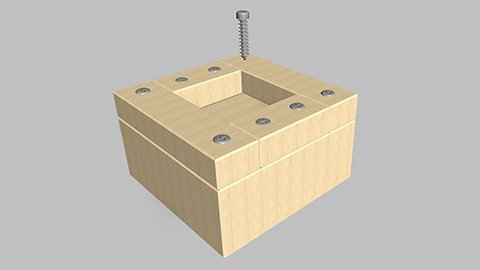
Planting bare-rooted trees
Follow the instructions in steps 1-3. For step 4:
- Carefully remove any material (such as sawdust, moss, or burlap) from around the roots.
- Look closely at the trunk to the point where the soil surface was. If you can’t see it, assume that it was about 30-50mm up from the top of the highest root.
- Once your stakes are in place, ask an assistant to hold the tree so the previous soil line is level with the surrounding soil surface.
- Carefully fill in the hole taking time to make sure no air pockets form around the roots.
- Continue with the steps for potted trees.
Planting into lawn
- In step 3 cut the turf off by using the spade to cut a pattern of crosses across the area. Then cut in almost horizontally to skim the turf off. Dispose of the turf.
- In step 4, once the tree is planted, stakes installed, and hole backfilled dig the extra 300mm unturfed area around the hole, so it angles down at the edges and sits about 100mm below the surrounding turf (see image below).
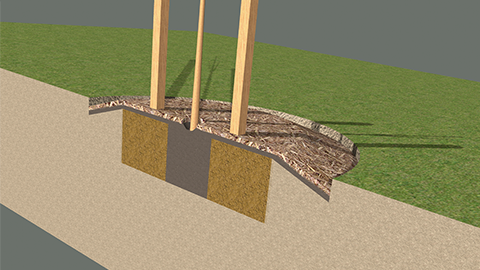
Why have we done it that way?
How does this link to what we’ve learned about soil in the previous topics?
- We applied liquid fertiliser to give the plant a nutrient boost, as a way of helping overcome the stress that trees undergo when being transplanted.
- We didn’t loosen the soil beneath the root ball as we wanted to provide a firm surface for it to sit on. This is so it is less likely to move around in strong wind (remember that a key role of soil is to anchor, or hold, the plant).
- We scored the side of the hole to encourage roots to spread out, by making that edge more permeable.
- We are reinstating the soil in the correct order so that it was as much like the surrounding soil as possible.
- We added amendments on top of the backfilled hole, not in the hole, so as to mimic nature’s own processes.
- We cleared back more of the turf so that the grass so won’t be able to compete with our tree for nutrients.
